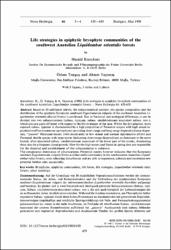Life strategies in epiphytic bryophyte communities of the southwest Anatolian Liquidambar orientalis forests
Abstract
Based on 30 additional releves, the syntaxonomical position, the species composition and the distribution of the epiphytic Scorpiurio sendtneri-Zygodontetum vulgaris of the southwest Anatolian Liquidambar orientalis alluvial forests is confirmed. Due to floristical and ecological differences, it can be divided into two subassociations (subass. typicum, subass. cinclidotetosum mucronati subass, nov.), which also are quite different with respect to the life strategies of the taxa. Whilst the dry-adapted, more exposed subass. typicum is characterized by a high proportion of Perennial stayers with high sexual reproductive effort (numerous sporophytes) providing short-range and long-range dispersal (chance dispersal), "passive" Perennial stayers (with moderately or low sexual and asexual reproductive effort) and Perennial shuttle species with large spores (indicating short-range dispersal) are co-dominant in the more humid, often inundated subass. cinclidotetosum mucronati of the lower part of the trunks, dominating these sites by a frequent clonal growth. How far the high waters and floods in spring time are responsible for the dispersal and establishment of this subassociation is unknown. The conspicuous dominance of pleurocarpous Perennial stayers however indicates that the Scorpiurio sendtner-Zygodontetum vulgaris forms a rather stable community in the southwestern Anatolian Liquidambar relict-forests, even tolerating disturbances and are able to regenerate, colonize and recolonize new potential habitat sites successfully.


















